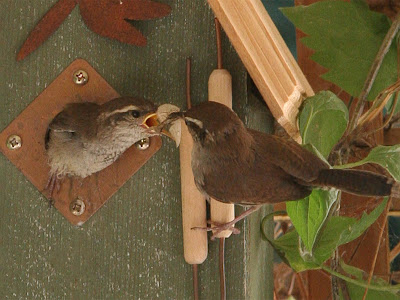If you have a small boisterous brown bird with a white eye line flitting through your shrubs, stopping every so often to belt out lovely warbles, whistles, and trills, you have a Bewick’s Wren.
He and his mate are probably year-round residents.
Those lively buzzes, trills, warbles and bubbly songs of these wrens bring such joy to my ears.
The male Bewick’s Wren sings to protect his territory, which he takes quite seriously, and to attract a mate.
Those lively buzzes, trills, warbles and bubbly songs of these wrens bring such joy to my ears.
The male Bewick’s Wren sings to protect his territory, which he takes quite seriously, and to attract a mate.
This is a full-time effort, especially since he must endeavor to win his mate by melodiously belting out up to 22 different songs in his repertoire, and to keep other males away.
Since the majority of these local wrens stay paired they are usually the first perching birds (passerines) in this area to start nesting.
Once he has won the affection of this year’s mate, the male fashions three or four nests full of twigs for the female’s approval.
 |
| Active nest box near house Photo by Craig Kerns |
Once he has won the affection of this year’s mate, the male fashions three or four nests full of twigs for the female’s approval.
These are often in the most unusual places; hose bib covers, boots, corners of carports, all hidden near human habitation.
When the female has selected the preferred nest location, she will finish it with feathers, hair, leaves and mosses and a soft warm cup for her eggs.
While the female sits on her 4-6 eggs the male brings food to her, and he helps feed their offspring. The female often has a second brood.
These spunky hyperactive little birds, with their tails cocked over their backs, can be found climbing on branches, skulking in blackberry brambles, sometimes upside down, and investigating the leaves on the ground, looking for their buggy delicacies, especially those tasty spiders.
If you go too close to them while they are searching for food, they will often scold you.
Fledgling Bewick’s Wrens are the same size as their parents when they leave their nests, only their tail feathers still need to finish growing.
Bewick’s Wrens will readily use a nest box near/against your house. They don’t like high-traffic areas and won’t make nests out in the open.
When the female has selected the preferred nest location, she will finish it with feathers, hair, leaves and mosses and a soft warm cup for her eggs.
While the female sits on her 4-6 eggs the male brings food to her, and he helps feed their offspring. The female often has a second brood.
.jpg) |
| Score a spider Photo by Craig Kerns |
If you go too close to them while they are searching for food, they will often scold you.
 |
| Extermination at your service Photo by Craig Kerns |
Since their eyebrows are rough and uneven these juvies look unkempt until they molt into their adult feathers the next year.
Your yard is being used by one of the best insect and spider eliminators, so don’t use pesticides which will likely kill these delightful super-bug-eaters.
Your yard is being used by one of the best insect and spider eliminators, so don’t use pesticides which will likely kill these delightful super-bug-eaters.
Let these energetic birds be your bubbly exterminators.


I had a pair on my Texas balcony this morning
ReplyDeleteI heard them before I saw them